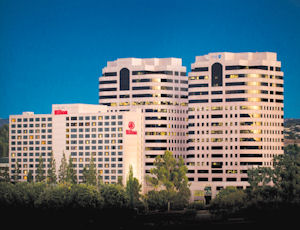The 25-year-old Hilton in Woodland Hills is about to undergo a major top-to-bottom renovation that will include a new lobby concept being popularized in business hotels: a Wi-fi-connected coffee shop atmosphere. Hotel management said the remodel could cost somewhere between $20 and $30 million, and will include changes to both the exterior and interior of the 325-room, suburban business hotel. Every room will get a major overhaul with new fixtures, bathrooms and furniture, said Ralph Suda, the new general manager. A major element of the redesign will be a totally redesigned lobby where customers can order light food and beverages throughout the day and night and connect to the Internet to conduct business. “A traditional lobby with couches has become wasted space in a hotel,” Suda said. “It’s a thing of the past.” The renovation comes as business travel is returning and area hotels report rising occupancy rates. The Hilton has seen its occupancy rates increase from a low-point in the 60 percent range just two years ago to 72 to 80 percent in recent months, former general manager Francois Khoury said in an interview earlier this month. Suda, who recently replaced him, said occupancy figures were confidential. Many of the nearby companies — from Northrop Grumman to Farmers Insurance — are getting more out-of-town visitors, which is good news for the hotel, Khoury has said, noting that because of the resurgence in business travel, the hotel has been able to hire back some 30 employees that were previously laid off. Suda said the renovations are not expected to get underway until about November. But the redesign has already begun. San Francisco-based Stanford Hotels, which owns the hotel and 12 other properties, is starting with a couple of redesigned model rooms. Those rooms will be critiqued by hotel employees, Stanford management and even Hilton. If the rooms pass muster, the design will be extended to the rest of the property. Suda said materials have already begun arriving for the redesign and he expects construction to begin sometime around Thanksgiving. Designers in San Francisco meanwhile are already at work on the lobby redesign. Suda said the hotel will, in all likelihood, do away with the traditional lobby design, which features a check in desk and couches, a business center, a bar off in one corner and a small full-service restaurant in the other. In its place, the hotel plans to install what some call the great room concept, which Hilton unveiled last year. The new lobby concept includes what Hilton has called “a flexible layout with a living room feel that encourages a social atmosphere where guests can interact, work, and collaborate.” Food and beverages would be served in the lobby throughout the day. There would be communal work tables allowing people to work on their laptops and socialize and pod-style check-in stations. Marriott unveiled a similar lobby concept late last year. The idea behind the trend is to accommodate travelers who like to socialize and work in the lobby. For many executives — especially women — conducting business in a room or even the hotel bar often feels uncomfortable. They prefer the open living room type environment. But until now, the space was not conducive to the way people do business. Nor was it contributing much to a hotel’s bottom line. As hotels have added food and beverage service in the lobby, revenues have increased, according to published reports. Since rolling out its “Refreshing Business Lobby” concept, food and beverage sales per occupied room — a benchmark for how much revenue is generated from a customer — have doubled at Courtyard by Marriott hotels, which company officials have attributed to the lobby redesign. The Hilton redesign will follow what many cutting-edge Los Angeles hotels have been doing in recent years — eliminating dark hotel pubs, adding power-up stations in the lobby, and even eliminating the check-in stations in favor of creating social spaces, not unlike those at the local Starbucks. “We would like to have an open space in the lobby and incorporate what today’s business traveler wants to see — food services and a place to meet and work,” Suda said.
